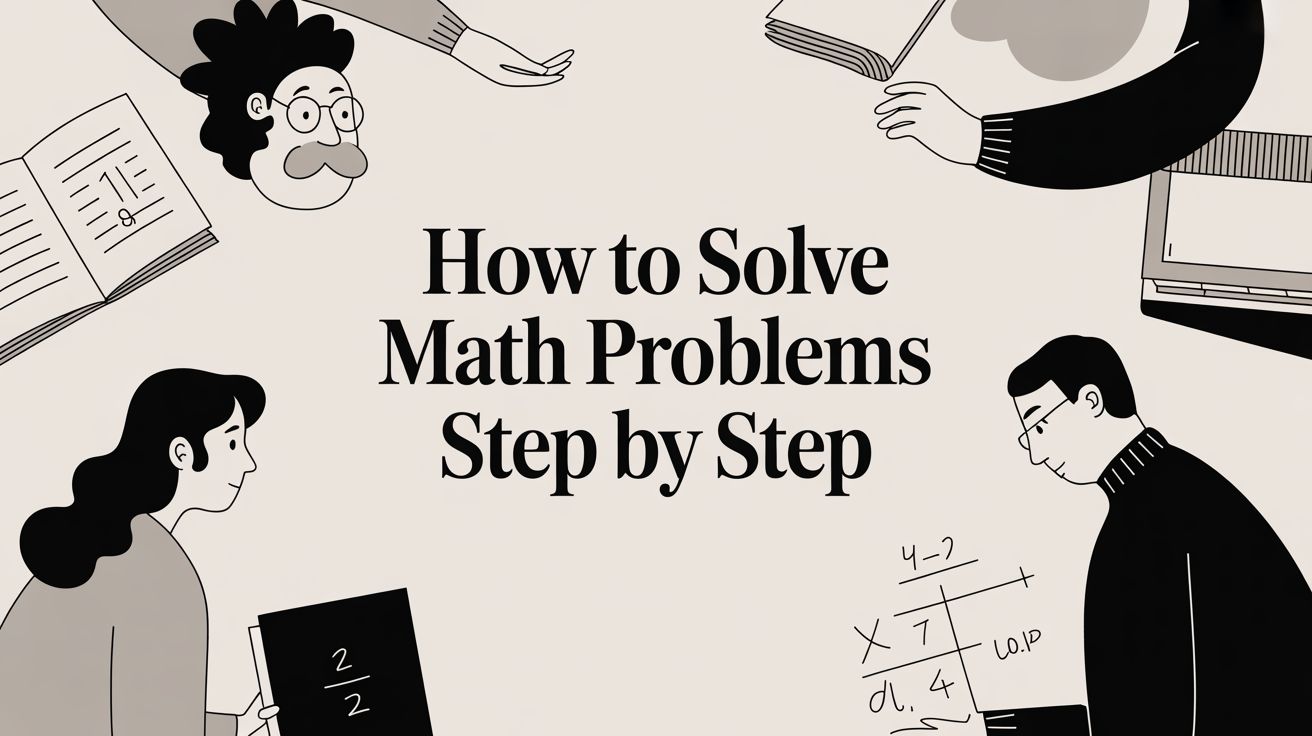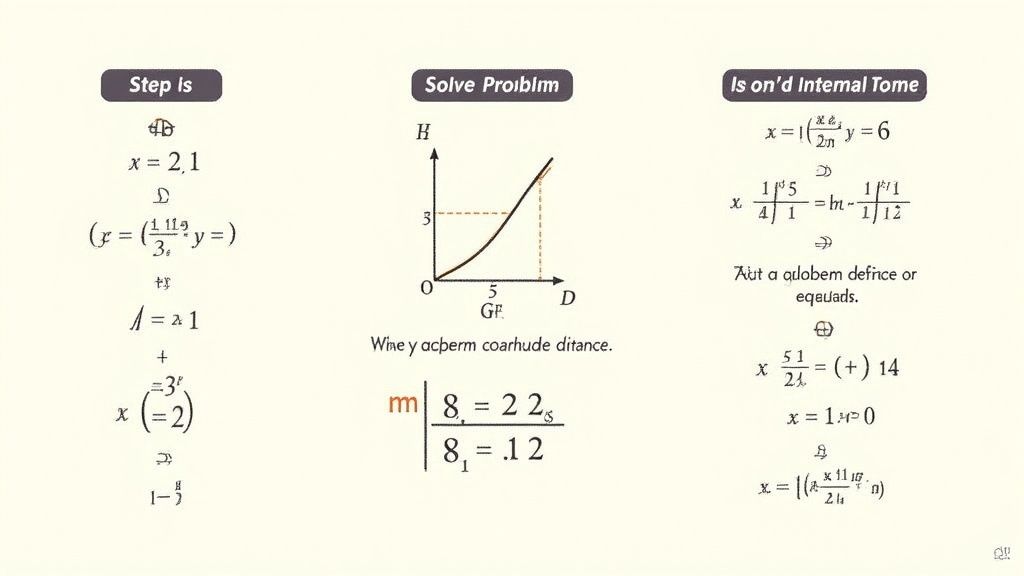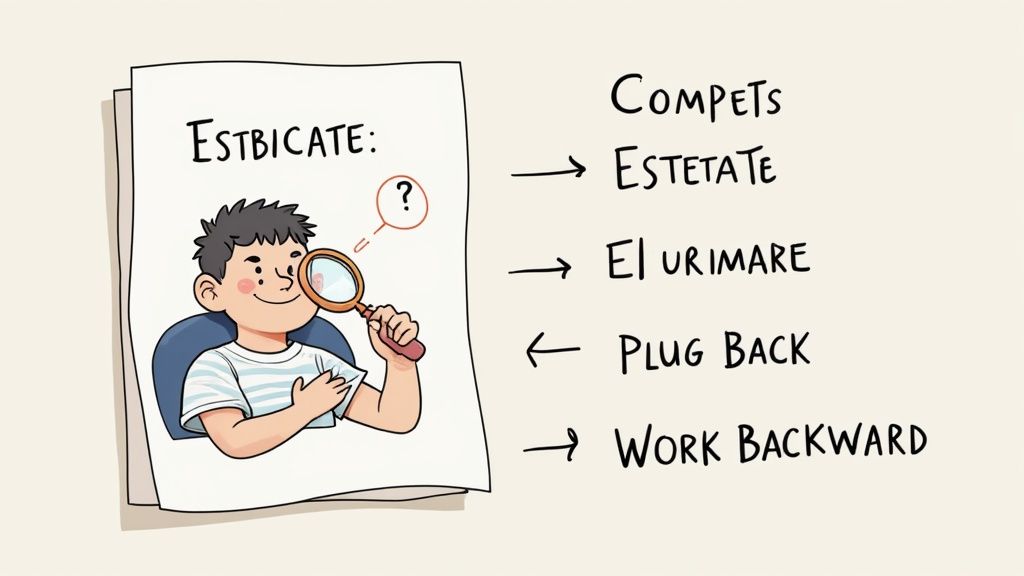How to Solve Math Problems Step by Step
Struggling with math? This guide breaks down how to solve math problems step by step using a proven framework, real examples, and modern tools.

To solve any math problem, you need a reliable game plan. It boils down to a classic four-step process: understand the problem, devise a plan, carry out the plan, and check your work. This structured approach is what turns a confusing jumble of numbers and symbols into a series of manageable tasks, building your skill and confidence along the way.
The real shift happens when you stop hunting for just the answer and start mastering the process.
Why a Strategic Approach to Math Changes Everything

Let's be honest—staring at a complex math problem can be intimidating. A lot of people chalk it up to not being a "math person," but the secret isn't some innate talent. It's strategy. Learning how to solve math problems step by step is less about memorizing formulas and more about developing a solid, repeatable method for thinking.
This kind of methodical approach lets you break down even the most daunting challenges into smaller, more digestible pieces. Instead of getting overwhelmed by the whole thing at once, you can focus on making steady, incremental progress. It's more than a classroom trick; it's how you build real confidence, sharpen your logical thinking, and dial down that all-too-common math anxiety.
Reframing the Challenge
The goal here is to change your internal monologue from "I can't solve this" to "Okay, where do I start?" When you have a structured process to fall back on, you always have a starting point. This simple act of reframing is key to pushing past mental blocks and building a better relationship with math.
This strategic mindset is also what separates students who excel from those who just get by. For example, the 2023 PISA results revealed that less than 10% of U.S. students reached advanced proficiency in math, suggesting only a small fraction have truly mastered complex, stepwise problem-solving. Compare that to top-performing countries like Singapore, where around 40% of students hit that high bar, largely because their curriculum hammers home methodical reasoning. You can find out more about these global math education trends for a deeper dive.
The Real-World Benefits
Getting good at this step-by-step process pays dividends far beyond homework and exams. This is exactly the kind of thinking that's prized in fields like engineering, finance, computer science, and data analysis.
The long-term goal of solving a mathematical problem is to increase your understanding of a subject. A good rule of thumb is that if you cannot adequately explain the solution of a problem to a classmate, then you haven’t really understood the solution yourself.
That deeper understanding is what it's all about. When you learn to approach problems systematically, you're building a versatile toolkit for life's challenges, whether you're figuring out a budget or debugging a line of code. It gives you the confidence to face any unfamiliar situation with logic.
Before we get into the nitty-gritty, this table lays out the core framework we'll be exploring. Think of it as your mental map for every problem you encounter from here on out.
The Four Pillars of Math Problem Solving
| Phase | Objective | Key Questions to Ask |
|---|---|---|
| 1. Understand the Problem | Define what's being asked. | What is the unknown? What information do I have? What are the constraints? |
| 2. Devise a Plan | Choose a strategy. | Have I seen a similar problem? Can I draw a diagram? Can I simplify it? |
| 3. Carry Out the Plan | Execute your strategy. | Am I checking each step as I go? Is my work clear and organized? |
| 4. Check Your Work | Verify your solution. | Does the answer make sense? Can I solve it another way to confirm? |
This four-phase approach, often credited to mathematician George Pólya, is the foundation of effective problem-solving. Let's break down what each phase looks like in practice.
The Universal Framework for Any Math Problem

It doesn't matter if you're staring down a simple algebra equation or a beast of a calculus problem—the core strategy for cracking it is almost always the same. Instead of trying to memorize a hundred different niche tricks, it’s far better to master a single, powerful toolkit you can apply to anything. This universal, four-stage framework is your go-to game plan for dismantling any math challenge that comes your way.
Once you get this process down, you’ll learn how to solve math problems step by step for good, not just for the next quiz. It’s a total mindset shift, moving you from a panicked search for the answer to a calm, methodical execution of a solid plan.
Step 1: Decode the Problem First
Before you even dream of touching your calculator, you need to play detective. So many students torpedo their efforts right here by jumping straight into the calculations. They scan for numbers, grab a formula, and hope for the best. That's a recipe for disaster.
Your first job is to truly understand what the problem is asking. Read it once to get the big picture. Then read it again, but this time, slow down. Highlight key information, pinpoint the unknown you need to solve for, and take note of any conditions or constraints. This simple habit of slowing down at the start will save you a world of frustration later.
Your first goal isn't to solve the problem; it's to understand its story. Every word problem, equation, or proof has a narrative. Figure out the characters (variables), the plot (the operation), and the ending (what you need to solve for).
This foundational skill is absolutely crucial. Data from the Trends in International Mathematics and Science Study (TIMSS) shows just how much this procedural understanding matters. In 2019, 14 other education systems, including Singapore and South Korea, scored significantly higher than the U.S. This highlights a stronger global emphasis on teaching methodical, step-by-step problem-solving right from the start.
Step 2: Devise a Strategic Plan
Okay, you’ve got a handle on the question. Now it's time to map out your attack. This stage is all about strategy, not execution. Think of yourself as a general deciding on the battle plan before sending in the troops. What mathematical tools in your arsenal are right for this job?
Here's what your planning phase might look like:
- Fish for formulas. Which equations connect the information you have with the unknown you need to find?
- Draw it out. A quick sketch or graph can turn an abstract problem into something you can actually see. This is a lifesaver in geometry, physics, and even many algebra problems. Visualizing atomic structures, for example, is essential in chemistry—a concept we dive into in our guide to the Bohr diagram for nitrogen.
- Break it down. If it’s a multi-step monster, chop it into smaller, manageable pieces. What's the first domino you need to knock over to get to the second part?
- Look for familiar patterns. Have you seen a problem like this before? Recognizing a familiar structure is a huge advantage.
Taking a moment to plan prevents you from just guessing and checking randomly. It’s an investment that pays off by saving you time and preventing silly mistakes.
Step 3: Execute Your Plan with Precision
Now it's time to roll up your sleeves and do the math. With a deep understanding of the problem and a clear plan, this part becomes much more manageable. The key here is precision.
Work through your plan one step at a time. Show your work clearly and logically. Please, don't try to juggle multiple calculations in your head—that’s where simple arithmetic errors creep in. Writing everything down creates a clear trail you can follow if you need to double-check something later. Stay organized and focused. A deliberate pace is often the fastest way to the right answer.
Step 4: Review and Reflect on Your Work
This final step is the one almost everyone skips, and it's what separates the good students from the great ones. Once you have an answer, you're not done. You need to look back and make sure it’s correct and actually makes sense in the context of the problem.
Ask yourself a few quick questions:
- Does this answer seem reasonable? If you were calculating the speed of a car and got 5,000 miles per hour, you've probably made a mistake somewhere.
- Can I plug it back in? For tons of algebra problems, this is a foolproof way to know if your solution is correct.
- Did I answer the actual question? It's surprisingly easy to solve for 'x' but completely forget the question was asking for '2x+1'.
This final check is your quality control. It builds confidence and helps you catch careless mistakes before they cost you points. Mastering this four-stage framework will give you the structure you need to tackle any math problem with clarity and confidence.
Seeing the Method in Action with Worked Examples

Theory gives you the map, but it’s the guided tour that really teaches you the terrain. The real learning happens when we take that universal framework—understand, plan, execute, and review—and apply it to actual problems. Seeing how these stages flex and adapt to different challenges is what builds genuine, resilient problem-solving skills.
Let's walk through three distinct examples: a common algebra equation, a foundational calculus problem, and a classic word problem. The goal isn't just to get the right answer; it's to peel back the curtain on the thinking process behind each step. Think of the annotations as a tutor's voice, explaining the "why" behind every move and tying it back to our core strategy. This is how to solve math problems step by step in a way that builds lasting intuition.
Tackling a Multi-Step Algebra Equation
Let's start with a problem you'd see in any standard algebra class. Our mission here is to get the variable 'x' all by itself.
Problem: Solve for x in the equation 5(x + 2) - 12 = 3x - 4.
First, understand the problem. A quick scan shows we have the variable x on both sides of the equation, a set of parentheses, and a few constants. Our goal is to find the one value of x that makes the whole statement true.
Next, devise a plan. A solid strategy is to simplify each side first. I'll distribute the 5 to get rid of the parentheses, then combine any stray constants. From there, I'll herd all the x terms to one side and all the numbers to the other. The final move is to isolate x.
Now, let's carry out the plan:
- Distribute:
5 * x + 5 * 2gives us5x + 10. The equation now looks cleaner:5x + 10 - 12 = 3x - 4. - Combine Like Terms: On the left,
10 - 12simplifies to-2. Now we're at5x - 2 = 3x - 4. Much better. - Gather Variables: To get the
x's together, I'll subtract3xfrom both sides. This leaves me with2x - 2 = -4. - Gather Constants: Let's get the numbers on the other side by adding
2to both sides. That gives us2x = -2. - Isolate x: The final step is to divide both sides by
2, which leaves us with the answer: x = -1.
Finally, check your work. Don't skip this part! Plug x = -1 back into the original equation: 5((-1) + 2) - 12 = 3(-1) - 4. This becomes 5(1) - 12 = -3 - 4, which simplifies to 5 - 12 = -7, and sure enough, -7 = -7. The solution holds up.
Translating a Word Problem into Math
Word problems often feel intimidating because that first step—understanding what's being asked—can be the hardest part. Let's break one down methodically.
Problem: A rectangular garden is 5 feet longer than it is wide. If the perimeter of the garden is 50 feet, what are its dimensions?
Before touching a calculator, we need to fully understand the problem. We're looking for two numbers: the length and the width of a rectangle. We've been given two critical clues: a direct comparison between the length and width, and the garden's total perimeter.
Okay, time to devise a plan. I'll start by assigning variables to the unknowns. Let W be the width and L be the length. My next move is to translate the English sentences into two distinct mathematical equations. Once I have those, I can use the standard perimeter formula (P = 2L + 2W) to tie everything together and solve.
The most common mistake in word problems is rushing to calculate. Spend extra time translating the words into a clear mathematical setup. A good plan makes the execution phase simple.
Executing the Word Problem Plan
With a clear plan, the execution is just a matter of going through the motions.
- Translate: The phrase "A garden is 5 feet longer than it is wide" directly translates to the equation L = W + 5.
- Use the Formula: We know the perimeter
Pis 50, so we can plug that into the formula: 50 = 2L + 2W. - Substitute and Solve: Now we have a system of two equations. The easiest way forward is to substitute the first equation into the second one:
50 = 2(W + 5) + 2W.- First, distribute the 2:
50 = 2W + 10 + 2W. - Next, combine the
Wterms:50 = 4W + 10. - Subtract 10 from both sides:
40 = 4W. - Finally, divide by 4: W = 10 feet.
- First, distribute the 2:
- Find the Other Dimension: We're not done yet! We use our first equation,
L = W + 5, to find the length:L = 10 + 5, which means L = 15 feet.
Let's do a quick final check: P = 2(15) + 2(10) = 30 + 20 = 50. Perfect. The dimensions are correct. This substitution technique is a workhorse in mathematics, and it's a core concept you'll see again when you learn how to solve logarithmic equations.
Using Modern Tools to Sharpen Your Skills
Mastering a classic problem-solving process is essential, but you don't have to go it alone. The frameworks we use are timeless, but the tools at our disposal are more powerful than ever. Instead of staring at a single problem for hours, you can use modern resources as a personal tutor to get unstuck, make sense of tough concepts, and speed up your learning curve.
The trick is to use these tools for genuine understanding, not just for a quick answer. Think of an AI tool like Feen AI as a knowledgeable study partner. Its job is to walk you through the logic behind a solution, helping you connect the dots so you can crush similar problems on your own next time. It’s an active approach that’s far more effective than just copying an answer from the back of the book.
Turning AI into Your Personal Tutor
The real magic of using AI for math is getting on-demand, step-by-step explanations whenever you need them. It's late, you're stuck on a homework problem, and a human tutor isn't an option. This is where AI tools bridge the gap and keep your study session from grinding to a halt.
Getting help can be as simple as snapping a picture of the problem. Here’s what it looks like in Feen AI when you’re ready to upload something from a worksheet or textbook.
The clean, chat-based format makes it easy to ask for a detailed breakdown. Once you get the solution, you can start digging deeper to make sure you actually get it.
This kind of interaction is right in line with modern teaching methods. There’s a growing shift toward hands-on, project-based learning to teach students how to solve math problems step by step. Immersive tools, like AI-powered tutors, let you explore solutions interactively, which makes the logical flow much clearer than a static page in a textbook. A recent report noted that this kind of hands-on experience can dramatically improve how well students grasp and remember math concepts. You can explore more about these educational findings from Brighterly to see how the learning landscape is changing.
Asking Smarter Follow-Up Questions
Getting the step-by-step solution is just the starting point. The most critical part comes next: interrogating the explanation. This is where the real learning kicks in. Don't just accept the answer. Treat the AI like a tutor and pepper it with clarifying questions.
Here are a few powerful follow-ups to try:
- "Why was this specific formula the right one to use here?" This pushes the AI to explain the strategy behind the solution, not just the mechanics.
- "Can you show me a different way to solve this?" Seeing multiple methods deepens your understanding and proves there's often more than one path to the right answer.
- "What's a common mistake people make on problems like this?" This is gold. It helps you anticipate traps and avoid them when you're on your own.
- "Explain [insert term] like I'm 10." If a word like "derivative" or "logarithm" is fuzzy, ask for a simple analogy or definition.
An AI helper is like a calculator. It can do the heavy lifting, but you still need to know which buttons to press and why. Your goal is to learn the ‘why’ behind every step, not just copy the output.
This back-and-forth dialogue transforms you from a passive observer into an active participant in your own education.
Using AI for Verification and Deeper Exploration
Another fantastic way to use AI is to check your own work. First, solve the problem yourself from start to finish. Write down every single step. Then, use a tool like Feen AI to check your final answer and, more importantly, compare your logic to its breakdown.
This habit is incredibly useful for a few reasons:
- Immediate Feedback: You don't have to wait for class or graded homework to see if you're on the right track.
- Pinpointing Errors: By comparing your work line-by-line, you can see exactly where you went astray. Was it a simple calculation mistake or a fundamental misunderstanding of a concept?
- Reinforcing Correct Methods: When your process lines up with the AI's, it's a huge confidence booster and solidifies the correct technique in your mind.
By folding these tools into your study routine, you create a powerful feedback loop. You'll get unstuck faster, verify your reasoning on the spot, and explore concepts more deeply than ever before—turning every problem into a true learning opportunity.
How to Find and Fix Your Own Mistakes

Everyone makes mistakes in math. That’s a given. The real skill isn't about being perfect on the first try; it's about getting incredibly good at finding and fixing your own errors. This process, which programmers call debugging, is what separates people who stay stuck from those who push through and solve the problem.
Think like a coder for a minute. When their code breaks, they don't just stare at it and hope for the best. They have a system: they test, isolate the problem, and then fix it. You can bring that same methodical approach to your math homework and become a much more independent and resilient learner.
Develop Your Error-Detection Instincts
Before you can fix a mistake, you have to realize you've made one. Sometimes it's a glaring error, but more often, it's something subtle. You have to train your brain to get that "gut feeling" when an answer just seems off.
One of the best ways to do this is through estimation. Before diving into the calculations, take a second to ballpark a reasonable answer. If you're calculating the area of a classroom and your answer is in the millions, a little alarm bell should go off in your head. That quick gut check is your first line of defense against a nonsensical result.
An incorrect answer isn't a failure—it's a clue. Your mistake is a signpost pointing directly to a gap in your understanding. It's giving you a golden opportunity to strengthen that specific weak spot.
Changing how you see mistakes is a huge part of learning how to solve math problems step by step. It turns frustration into a productive investigation.
Common Problems and Their Solutions
So, you know your answer is wrong, but you have no idea why. Don't just erase everything and start over—that’s a recipe for frustration. Instead, run some diagnostics like a pro.
Problem: Your answer feels totally random or makes no sense.
- Solution: Work backward. Take your final answer and start doing the opposite operations to see if you can get back to the numbers you started with. If you can't, you know you've got a calculation error hiding somewhere in your steps.
Problem: You aren't sure you used the right information from the question.
- Solution: Re-read the question after you think you're done. It’s so easy to solve for
xwhen the question actually asked for the value of2x+1. A final read-through makes sure you actually answered the question that was asked, not the one you thought was asked.
Problem: You’re pretty sure it’s a simple calculation mistake, but you can’t spot it.
- Solution: Plug your answer back into the original equation. This is the ultimate truth test in algebra. If you plug your value for
xback in and the two sides of the equals sign don't match up, you have hard proof of an error. Now you can go back line-by-line to find it.
This process of checking your work is just as important as getting the answer in the first place. Studies on learning show that the ability to verify a solution is a critical skill for true mastery.
Building Resilient Habits
Becoming a good math debugger isn't a one-time trick; it's about building solid, consistent habits. Use every problem, even the ones that seem easy, as a chance to practice this methodical approach.
- Show Your Work Clearly: A messy page is where errors love to hide. Keep your steps organized so you can actually follow your own logic later.
- Check as You Go: Don't wait until the very end to see if you're on track. After a tough calculation, pause and ask yourself, "Does this intermediate number make sense?"
- Try to Explain It: If you can’t explain your solution clearly to a friend (or even just out loud to yourself), you probably don't understand it as well as you think you do. This is a fantastic test of your own comprehension.
When you make these debugging techniques a regular part of your routine, you start catching errors faster and more efficiently. This doesn't just improve your grades; it builds real confidence and turns the frustrating cycle of making mistakes into a powerful engine for getting better.
Building a Practice Routine That Actually Sticks
Let's be honest: you don't master math by cramming the night before an exam. That's a recipe for burnout and fleeting knowledge. Real skill—the kind that sticks with you—is built brick by brick through consistent, thoughtful practice. The goal isn't to turn your life into a non-stop study session, but to create a smart routine that feels less like a chore and more like a habit.
Quality beats quantity every single time. It's far better to spend 30 minutes wrestling with five tough problems than to breeze through twenty easy ones on autopilot. Deep learning happens when you're forced to think, to find your weak spots, and to really internalize the problem-solving process.
Designing Your Practice Schedule
There’s no magic formula here. The best routine is the one you can actually stick to. You need to find a rhythm that works with your schedule, your energy levels, and your life.
Here are a couple of approaches I've seen work wonders:
- The Daily 20: Just commit to 20-30 minutes of focused math practice every day. This keeps the concepts fresh in your mind and prevents that awful feeling of being overwhelmed. It’s perfect for working through daily homework or reviewing notes from class.
- The Focused Block: If daily sessions feel too scattered, try setting aside two or three longer chunks of time—say, 60-90 minutes—each week. Weekends are often great for this. Use this time to really dive into new material, tackle a challenging problem set, or prep for a big test.
Whatever you choose, put it in your calendar. Treat it like a doctor's appointment or a coffee meeting with a friend. When it's written down, you're much more likely to actually do it.
Staying Motivated and Tracking Progress
Momentum is everything. One of the best ways to keep going is to see how far you've come. Keep a simple log of the topics you've covered or the number of problems you’ve nailed. Seeing that progress laid out in black and white is a surprisingly powerful motivator.
The journey to mastering math truly begins with a single, confident step. Your goal today isn't to solve every problem in the book—it's just to solve one problem using the entire framework, from understanding to checking your work.
You also have to celebrate the small victories. Did you finally figure out that one type of problem that always tripped you up? That's a big deal! Acknowledge it. This kind of positive reinforcement helps you build a much healthier, more confident relationship with math. This idea of breaking down big goals applies to more than just equations; for more on structuring your efforts, our guide on how to write an essay fast covers similar principles.
Ultimately, you want to create a positive feedback loop: practice leads to understanding, which builds confidence, which makes you want to practice more. So start small. Tonight, pick just one problem from your homework and walk it through the four-step framework we covered. Don't just hunt for the answer—decode the question, map out a plan, execute it carefully, and then double-check your work. That single, deliberate effort is the most important step you can take.
Ready to make your study sessions more effective? Feen AI can be your personal tutor, providing step-by-step explanations for even the toughest problems. Upload a photo of your assignment and get the clear, detailed help you need to build real understanding and confidence. Try Feen AI for free and see the difference.
Relevant articles
Struggling with hard math problems? Discover proven strategies, practical frameworks, and smart AI tips to conquer complex challenges and boost your skills.
Learn how to graph linear inequalities with this easy-to-follow guide. Discover how to handle dashed lines, shading, and systems with real-world examples.
Struggling with how to find domain and range? Our guide unpacks the process with clear examples for graphs and equations, making algebra concepts simple.
How to solve calculus problems: Master step-by-step methods, common pitfalls, and practice sets to boost your calculus confidence and scores.
Learn how to solve word problems in algebra using practical strategies. This guide breaks down the process with real examples and tips to build your confidence.
Discover how to solve systems of linear equations with clear steps, example problems, and practical tips to boost your confidence.





